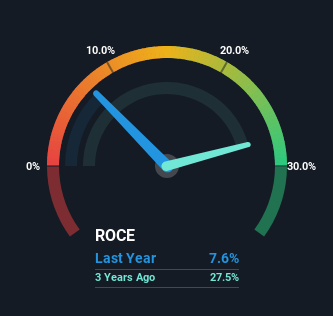- United States
- /
- Specialty Stores
- /
- NYSE:CWH
Returns On Capital At Camping World Holdings (NYSE:CWH) Paint A Concerning Picture

What are the early trends we should look for to identify a stock that could multiply in value over the long term? Firstly, we'd want to identify a growing return on capital employed (ROCE) and then alongside that, an ever-increasing base of capital employed. This shows us that it's a compounding machine, able to continually reinvest its earnings back into the business and generate higher returns. In light of that, when we looked at Camping World Holdings (NYSE:CWH) and its ROCE trend, we weren't exactly thrilled.
Return On Capital Employed (ROCE): What Is It?
For those that aren't sure what ROCE is, it measures the amount of pre-tax profits a company can generate from the capital employed in its business. Analysts use this formula to calculate it for Camping World Holdings:
Return on Capital Employed = Earnings Before Interest and Tax (EBIT) ÷ (Total Assets - Current Liabilities)
0.076 = US$226m ÷ (US$5.0b - US$2.1b) (Based on the trailing twelve months to March 2024).
So, Camping World Holdings has an ROCE of 7.6%. Ultimately, that's a low return and it under-performs the Specialty Retail industry average of 12%.
Check out our latest analysis for Camping World Holdings

In the above chart we have measured Camping World Holdings' prior ROCE against its prior performance, but the future is arguably more important. If you'd like to see what analysts are forecasting going forward, you should check out our free analyst report for Camping World Holdings .
What Does the ROCE Trend For Camping World Holdings Tell Us?
When we looked at the ROCE trend at Camping World Holdings, we didn't gain much confidence. Around five years ago the returns on capital were 9.7%, but since then they've fallen to 7.6%. Given the business is employing more capital while revenue has slipped, this is a bit concerning. If this were to continue, you might be looking at a company that is trying to reinvest for growth but is actually losing market share since sales haven't increased.
On a side note, Camping World Holdings' current liabilities are still rather high at 41% of total assets. This effectively means that suppliers (or short-term creditors) are funding a large portion of the business, so just be aware that this can introduce some elements of risk. Ideally we'd like to see this reduce as that would mean fewer obligations bearing risks.
The Key Takeaway
In summary, we're somewhat concerned by Camping World Holdings' diminishing returns on increasing amounts of capital. Yet despite these poor fundamentals, the stock has gained a huge 163% over the last five years, so investors appear very optimistic. Regardless, we don't feel too comfortable with the fundamentals so we'd be steering clear of this stock for now.
On a final note, we found 4 warning signs for Camping World Holdings (2 shouldn't be ignored) you should be aware of.
While Camping World Holdings may not currently earn the highest returns, we've compiled a list of companies that currently earn more than 25% return on equity. Check out this free list here.
New: AI Stock Screener & Alerts
Our new AI Stock Screener scans the market every day to uncover opportunities.
• Dividend Powerhouses (3%+ Yield)
• Undervalued Small Caps with Insider Buying
• High growth Tech and AI Companies
Or build your own from over 50 metrics.
Have feedback on this article? Concerned about the content? Get in touch with us directly. Alternatively, email editorial-team (at) simplywallst.com.
This article by Simply Wall St is general in nature. We provide commentary based on historical data and analyst forecasts only using an unbiased methodology and our articles are not intended to be financial advice. It does not constitute a recommendation to buy or sell any stock, and does not take account of your objectives, or your financial situation. We aim to bring you long-term focused analysis driven by fundamental data. Note that our analysis may not factor in the latest price-sensitive company announcements or qualitative material. Simply Wall St has no position in any stocks mentioned.
Have feedback on this article? Concerned about the content? Get in touch with us directly. Alternatively, email editorial-team@simplywallst.com
About NYSE:CWH
Camping World Holdings
Together its subsidiaries, retails recreational vehicles (RVs), and related products and services in the United States.
Reasonable growth potential and fair value.
Similar Companies
Market Insights
Community Narratives



